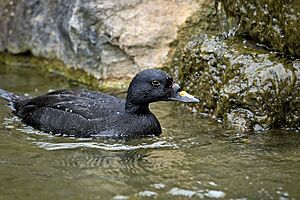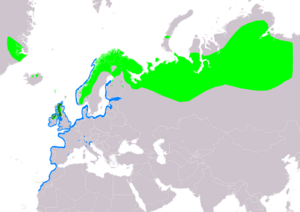Common scoter facts for kids
Quick facts for kids Common scoter |
|
|---|---|
 |
|
| Conservation status | |
| Scientific classification | |
| Genus: |
Melanitta
|
| Species: |
nigra
|
 |
|
| Range of M. nigra Breeding Resident Non-breeding | |
| Synonyms | |
|
Anas nigra Linnaeus, 1758 |
|
The common scoter (Melanitta nigra) is a large sea duck. It's about 43 to 54 centimeters (17 to 21 inches) long. These ducks breed in the far northern parts of Europe and Asia, as far east as the Olenyok River. The black scoter from North America and eastern Siberia used to be thought of as the same species, but now they are considered different.
Contents
What's in a Name?
The common scoter was first officially described in 1758. This was done by a Swedish scientist named Carl Linnaeus. He gave it the scientific name Anas nigra in his famous book, Systema Naturae.
Later, in 1822, a German zoologist named Friedrich Boie created a new group, or genus, called Melanitta. The common scoter is now one of six species in this group. The name Melanitta comes from old Greek words. Melas means "black" and netta means "duck."
What Do They Look Like?
Common scoters have a bulky body shape and a large bill. The male common scoter is completely black. Its bill has a round shape and some yellow color near its nostrils.
Female common scoters are brown. They have pale, lighter-colored cheeks. They look very similar to female black scoters. You can tell common scoters apart from other scoters because the male has no white feathers. The female has more pale areas on her face. Also, common scoters and black scoters make different sounds.
Where Do They Live and What Do They Do?
Common scoters spend their winters in warmer places. They fly south to the coasts of Europe, even as far as Morocco. They gather in huge groups on the water. These groups are very close together. The birds often take off and dive at the same time.
Common scoters build their nests on the ground. They choose spots near the sea, lakes, or rivers. These nests are often in woodlands or open, treeless areas called tundra. Females usually lay 6 to 8 eggs.
These ducks mostly dive underwater to find food. They eat crustaceans like crabs and molluscs like clams. When they are in fresh water, they also eat water insects and small fish. The common scoter is a protected bird. It's part of an agreement to help save migratory waterbirds in Africa and Eurasia.
Common Scoters in the UK
In 1977, a bird expert named Bruce Campbell estimated how many common scoters spent winter in northwest Europe. He thought there were about 130,000, mostly around the Baltic Sea. About 20,000 were in the UK. Many common scoters also fly through the Straits of Dover in spring.
In 2003, a large group of over 50,000 common scoters was found. They were spending winter near Shell Flat in northwest England. This discovery happened when a company was looking for a place to build a new wind farm.
Even though most common scoters visit the UK in winter, some pairs do breed in northern Scotland. However, the number of breeding pairs in the UK has dropped a lot. Because of this, the RSPB (a bird conservation group) has put the common scoter on its "Red List." This means it's a species of high concern.
In 1998, the UK government created a plan to help the common scoter. They hoped to increase the breeding population to 100 pairs by 2008. Sadly, the number of breeding pairs in Northern Ireland fell sharply. By 2010, no breeding was confirmed there. In 2015, only 35 breeding pairs were found in the UK. Scientists are trying to understand why this is happening.
Scoters and Old French Traditions
Long ago, in parts of France, common scoters were sometimes eaten on Fridays. This was because the Roman Catholic Church had rules about not eating meat on Fridays. But they allowed fish.
Some people thought scoters tasted like fish. So, they were allowed to eat them instead of other meats. People would catch many scoters in nets near the coast. This was especially true when the birds came close to shore to find their favorite food, small shellfish.
Images for kids



